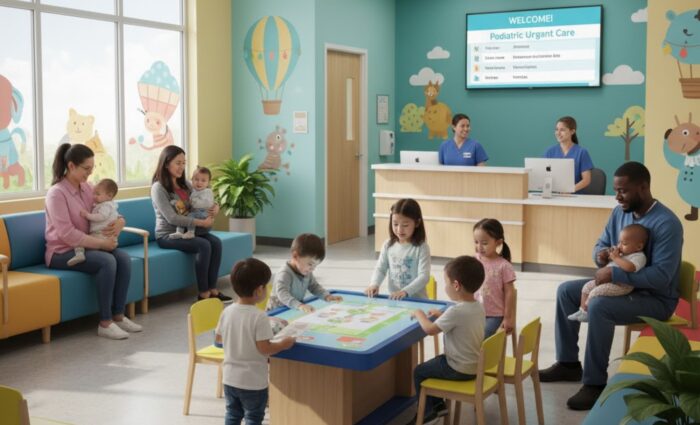When your child becomes ill or injured, deciding where to go can feel overwhelming. Do you wait for your pediatrician’s office to open or head straight to the emergency room? Pediatric urgent care fills that gap by providing immediate, high-quality medical care for ill and injured children. It offers prompt attention for conditions that aren’t life-threatening but still require quick treatment.
Families across the country are discovering how pediatric urgent care services deliver convenience, expertise, and compassion in one place. With walk-in care, extended hours, and skilled urgent care providers, these clinics offer a practical solution for parents. They give children timely medical help when their condition can’t wait until morning. Parents value the efficiency, professionalism, and caring approach of pediatric specialists. This guide explains what pediatric urgent care is, what to expect during a visit, how it differs from an emergency room, and why families trust Rego Park Diagnostic & Treatment Center for quality care.
What Is Pediatric Urgent Care?
Pediatric urgent care centers treat children from infancy through young adulthood for minor illnesses and injuries. Unlike general urgent care clinics, these centers employ pediatricians, nurses, and medical assistants with specialized training. They understand each child’s medical needs and deliver care suited to their age and condition.
These centers use child-sized tools, calming décor, and experienced staff to handle everything from a sudden fever to a sprained ankle. Most pediatricians’ offices are open only during regular business hours. As a result, many families depend on urgent care centers for medical support during evenings or weekends.
Common conditions treated include:
- Fever, coughs, and sore throats
- Ear infections and sinus issues
- Minor injuries like sprains, strains, and simple fractures
- Cuts, burns, and pink eye
- Rashes and allergic reactions
- Mild flu and dehydration
Pediatric urgent care centers provide evaluation, treatment, and comfort, helping your child recover quickly and return to their normal, bright-eyed, happy selves.
Pediatric Urgent Care vs. Emergency Room: Key Differences
When your child feels unwell, deciding between an urgent care center and an emergency room can be stressful. Both offer medical attention, but they serve different purposes.
The table below highlights the main differences:
| Condition | Pediatric Urgent Care | Emergency Room |
| Fever, sore throat, minor cut | Yes | Not necessary |
| Breathing difficulty, head trauma | No | Yes |
| Sprains or simple fractures | Yes | Usually not needed |
| Severe bleeding or loss of consciousness | No | Yes |
| Vomiting or mild dehydration | Yes | Only if severe |
In short, pediatric urgent care handles non-life-threatening emergencies while the pediatric emergency room manages severe or life-threatening cases. Choosing urgent care helps you avoid long wait times and reduce medical costs. It also ensures your child receives prompt medical attention from experienced doctors and nurses specializing in pediatric care.
When Should You Take Your Child to Urgent Care?
Knowing when to seek urgent care can save both time and stress. Parents often struggle to judge whether an illness or injury requires emergency care or if it can wait for the pediatrician’s office. At Rego Park Diagnostic & Treatment Center, our pediatric urgent care team helps families make confident care decisions. We provide prompt medical attention for non-life-threatening illnesses and injuries when your child needs help right away.
Visit a pediatric urgent care center if your child experiences:
- Fever that doesn’t improve with medication
- Ear pain, sore throat, or persistent cough
- Vomiting or diarrhea lasting more than 24 hours
- Mild allergic reactions (hives, swelling, or rash)
- Sprains, strains, or minor fractures
- Painful urination or abdominal discomfort
- Small cuts that may need stitches
As one urgent care provider explains, “Parents know their kids best. If something feels off, even if it’s minor, it’s worth getting checked.” Most centers welcome walk-in visits and see patients seven days a week. This accessibility is ideal for unexpected issues that can’t wait until the next appointment.
What to Expect During Your Visit
If this is your first pediatric urgent care visit, you may wonder what happens once you arrive. Fortunately, the process at Rego Park Diagnostic & Treatment Center is designed to be simple, efficient, and reassuring for both parents and kids. From the moment you walk in, our staff creates a calm and caring environment that helps families feel comfortable. Every child receives the expert care they need in a setting designed for safety and reassurance.
Here’s what typically happens during a visit:
- Check-In: Most centers accept walk-ins, but many allow you to “Save Your Spot” online to reduce long wait times.
- Evaluation: A nurse or medical assistant will review symptoms, medications, and history. Then, your child will see a pediatrician or urgent care provider.
- Testing & Treatment: Depending on symptoms, the team might perform a flu test, strep test, or x-ray. Treatments such as splinting, wound care, or sports physicals may be provided.
- Follow-Up & Discharge: You’ll receive discharge instructions and, if needed, communication will be sent directly to your child’s pediatrician for continuity of care.
Everything is done with clear communication, gentle bedside manner, and the goal of getting your child back to feeling happy and healthy as soon as possible.
How to Prepare Before Your Visit
Preparing for your urgent care visit ensures a smoother experience. Whether it’s a walk-in or scheduled appointment, having the right documents and information ready will save time and stress.
Before your visit, remember to bring:
- Your insurance card and photo ID
- A list of medications or allergies
- Your child’s immunization record (if available)
- Recent medical notes from your pediatrician
You may also want to call ahead or check your urgent care location’s website for online registration options. Many clinics now offer digital forms to speed up the check-in process. By preparing in advance, parents can help staff provide faster, more accurate evaluation and treatment.
Common Conditions Treated at Pediatric Urgent Care
Pediatric urgent care centers are equipped to handle a wide range of illnesses and minor injuries. Each facility is designed to deliver expeditious, high-quality care that helps kids recover quickly without the stress of an emergency room.
Some of the most common conditions treated include:
- Colds, flu, and sore throats
- Ear infections and sinus congestion
- Cuts, burns, and insect bites
- Sprains, fractures, and sports injuries
- Vomiting, dehydration, and stomach pain
- Allergic reactions and mild asthma attacks
- Pink eye and rashes
Having pediatricians available means your child receives age-appropriate evaluation and treatment in an environment that prioritizes comfort and reassurance.
Virtual Pediatric Care: A Convenient Option
Some pediatric urgent care centers now offer virtual visits. This is a perfect solution for mild conditions or busy families. Virtual care allows parents to connect with doctors or nurses using secure video conferencing from home.
Virtual appointments are great for:
- Cold or flu symptoms
- Skin rashes
- Medication refills
- Follow-up visits after an in-person urgent care visit
These services provide direct communication with healthcare professionals while maintaining the same standard of expert care as in-person visits. Families with multiple kids or tight schedules often appreciate this flexible option.
Insurance, Costs, and Accessibility
One of the biggest advantages of pediatric urgent care at convenient locations is its affordability compared to hospital emergency care. Families receive quality care without unexpected costs. Most clinics accept major insurance plans and provide transparent, upfront pricing for self-pay patients.
They also operate during extended hours, including evenings and weekends, to ensure convenient access to high-quality medical care. If your child’s needs are urgent but not severe, urgent care services help you avoid the financial and emotional strain of an ER visit. Always confirm copay and coverage details with your insurance provider before arrival.
Conclusion
Every child deserves expert care delivered with compassion and respect. Our clinics create a calm, child-friendly environment where parents and caregivers can feel confident that their children are in capable hands. We provide thorough evaluation, effective treatment, and thoughtful follow-up for a wide range of illnesses and injuries. Our care covers everything from colds and flu to sports physicals and minor fractures. Our goal is simple: to deliver quality care for your child when it matters most.
At Rego Park Diagnostic & Treatment Center, we’re here to make exceptional pediatric urgent care convenient and accessible for every family. With extended hours, board-certified pediatricians, and a compassionate team, we ensure your child receives the care they deserve. Contact us today to schedule a visit or learn more about our urgent care services
FAQs
Is pediatric urgent care expensive?
Pediatric urgent care is generally affordable compared to emergency room visits. Most centers offer transparent pricing and accept major insurance plans. Costs may vary depending on the type of visit, tests, or treatments needed.
Can urgent care do pediatric physicals?
Yes, urgent care can do pediatric physicals for school, sports, or camp requirements. These physicals are performed by qualified providers experienced in pediatric evaluation. Walk-ins are often welcome, making it convenient for busy families.
Is pediatric urgent care covered by insurance?
Yes, pediatric urgent care is usually covered by most major insurance plans. Coverage may vary, so parents should confirm copays and benefits before visiting. Many clinics also offer self-pay options with upfront, affordable rates.
What time does pediatric urgent care open?
Pediatric urgent care centers typically open early in the morning and stay open into the evening. Some locations offer extended or weekend hours for added convenience. Check your local clinic’s website for exact opening and closing times.




